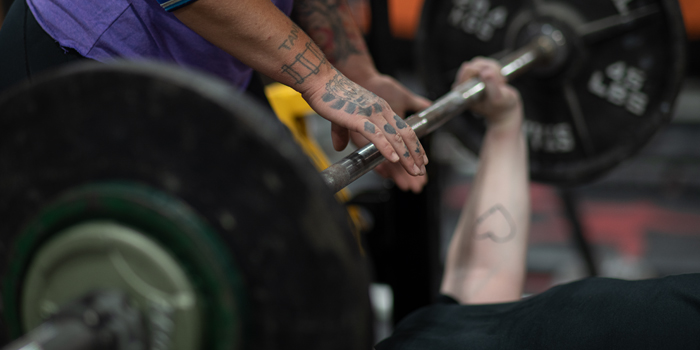
 The bench press is arguably the most popular lift performed in any gym, school, or garage in America. How many people ever stop a large guy to ask how much they squat or deadlift? The first thought most people have if you look like you lift weight is “How much ya bench?” How often do you see a guy with a large upper body and skinny legs compared to huge legs with a skinny upper body? The bench press is the prom king, handsome athlete, and class president everyone wants to be like. The squat is the mean bastard stepchild everyone is afraid of.
The bench press is arguably the most popular lift performed in any gym, school, or garage in America. How many people ever stop a large guy to ask how much they squat or deadlift? The first thought most people have if you look like you lift weight is “How much ya bench?” How often do you see a guy with a large upper body and skinny legs compared to huge legs with a skinny upper body? The bench press is the prom king, handsome athlete, and class president everyone wants to be like. The squat is the mean bastard stepchild everyone is afraid of.
I was a very good squatter but a pretty damn good bencher as well. I was a good bencher because I am lazy and it is the only lift you get to lay down to perform. So with this lift being so popular and synonymous with strength, how come so many people perform it so poorly? Why do so many have no real idea how to train for a bigger bench?
I find it a bit ironic that such a famous exercise is so misunderstood. I am actually just writing this article hoping some lifters will read these bench tips and actually do them so I can be less frustrated seeing so many lifters benching like shit!
12 Tips for a Stronger, Safer, More Efficient Bench Press
1. Use Your Entire Body
The bench press is a full body movement and if your legs, low back, and upper back are not sore and tired the day after bench training then you are not performing it correctly. If your feet are performing the river dance while you're benching then you're benching wrong. If your hips are simulating sex while benching then you're benching wrong!
2. Root Your Feet
Rooting is not just for squatting and deadlifting. You should be rooting your feet hard when performing a correctly executed bench press. Again, save the two-step and running man for somewhere other than the gym.
3. Root Your Hands, Too
We root our feet so why wouldn’t we root our hands as well? We are not gripping a flat surface such as the floor but instead gripping a bar. This does not mean we do a death grip on the bar though. When people death grip the bar, they tend to lock the bar straight across their palms which makes it that much harder to keep your elbows in the correct position. Try placing your hand on the bar then twisting your thumb into the bar. This automatically turns the elbows in while activating the lats, serratus anterior, and rhomboids. This will also run the bar from the thumb to the pinky finger instead of perpendicular to the hand. Only the pinky and ring finger will wrap all the way around the bar. So instead of a death grip on the bar and trying to compress the bar, you will just squeeze your fingers into the bar as if trying to flatten it.
4. Bend the Bar
Rooting of the hands should be intensified as the bar is descended in the eccentric phase of the lift—almost as if you're trying to bow the bar upwards towards your head. As you lower the bar, you're trying to bend it more. The bending of the bar starts with the root but it is also done with the depression of the shoulder blades by the lats. A good way to practice this is with a half piece of PVC, six feet long or so. It is easy enough to bend but if you practice some benches with it you'll see how much work your back and lats get.
5. Arch
I do not believe in trying to just wedge myself under the bar. Yes, I have a big arch, but I am using my muscles to hold that arch. Again, I'm not just trying to wedge myself under the bar.
I am trying to drive my shoulders in depression towards my butt with my lats while I am driving my butt to my shoulders with my leg drive. I find this is much easier if I put my legs out in front of me so I can not lift my butt off the bench but can drive my butt to my shoulders.
6. Get Upper Back into Position
The shoulder blades should be retracted and depressed on the bench. This means pulling the shoulder blades together with the rhomboids and middle traps and down with the lats.
7. Move the Bar in an Arc
The bench press moves in a slight arc. It is not a huge arc or a straight line. On the eccentric phase, it should slightly arc to the lower body and on the concentric, it should return to starting position with a slight arc toward the head.
This slight arch means you do not start with the elbows straight out and the bar over the clavicles. The bar should start with the shoulders down, elbows slightly in, and the weight loaded into the lats. This is a very stable and strong position where it should be easy to hold the weight.
8. Consider Elbow Position
Elbow position is different for raw or geared lifters. Raw lifters should be at, give or take, a 45-degree angle. Geared lifters should be in the same place or completely tucked into the side depending on which shirt they are using.
9. Set Up in the Right Place
Stop starting with your body so far down the bench and killing your handoff guy! If you're starting in the right position with the shoulders down, elbows in, and locked in the lats, then you can be closer to the racks. If you touch somewhere around the upper abs and press in a slight arc you should not hit the rack. Your handoff guys is getting nothing from helping you so take it easy on them and set up in the right place. They should only have to hand off a few inches, not half a mile.
Setting up in the right place on the bench also makes it easier to unrack the weight in the correct position. When we walk out a squat we want to do it in three short efficient steps right? Just say yes! When you set up way down the bench it makes it even harder to unrack the weight with the shoulders down and together like they are supposed to be. When having to reach too far up we tend to want to let our shoulders come out of depression and retraction.
10. Remember, the Bar Hits Where the Bar Hits
There is no set place everyone should touch the bar at the bottom of the press. We want our elbow and humerus bone close to 45 degrees (looking from the top) and we want our forearm a bit more than 90 depress because there is usually a small bit of bend in the wrist (looking from the side). Once those two angles are met then the bar hits where it hits. For some, this may be on the upper abs and for some, it may be just under the chest.
11. Brace
Just because your laying down doesn’t mean the brace isn’t important! The bench is a full body movement and if you have a soft squishy midsection then power from the lower body cannot travel to the upper body. Plus, we are in a tripod position with weight being supported across the shoulder and both feet. That squishy midsection leaves us with little support and stability. This is not sex in the supine position where you just lay there.
12. Bench Less
Trust me, I get the statement, "If a little works, more is better." I get the whole "outwork everyone" ideal. I even get being hard-headed. Damn, I was born and bred in Missouri whose state motto is “Show me.” Listen, if you want a bigger better bench, don’t bench more often. If one day a week isn’t giving you gains, then four or five days a week isn’t going to either. Fix your damn technique and educate yourself about benching. Try benching a little less while focusing more on the upper back and triceps training.
I have said it before and am saying it again, “Lifting is not rocket science, but damn it, you do need to use your brain.” There's no excuse in this day and age to not understand a lift. There's no reason you don't know what the muscles involved are and what the correct technique is. Well, I take that back. There is one excuse, but it is bullshit too. That excuse would be pure laziness which translates into no damn discipline. The very best and simplest advice I can give someone on how to increase their bench is to learn about the bench press and preferably from a lifter that has proven they know what they are talking about. The vast majority of lifters I see should be benching more weight with their current level of strength. If they would consider these tips, they'd increase their strength level which means their bench goes up even more. The mind controls the body so strengthening the mind will strengthen the body.










A great article and you've pretty much nailed it.
Something I particularly like, and that I've never actually tried before is, "Try placing your hand on the bar then twisting your thumb into the bar."
I always try to ensure that the bar is placed correctly in my hands, but I really like the idea of twisting your thumb into the bar. Makes a great deal of sense.
I'm also glad that you've mentioned shoulder retraction, as this is somehing I often see missed by many people who bench press.
Personally, I feel it provides a much more stable base and I'm able to brace my entire body better by using the upper back/shoulder retraction cue.
Partha